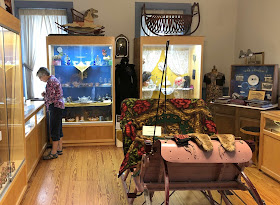While we are camped at Clinton Lake State Park, we are getting to spend time with our son, daughter-in-law, and granddaughter that live in Lenexa. One beautiful afternoon we took our inflatable kayak to Lake Lenexa so they could take it for a spin. They are on the lake in the kayak on the right side of the picture, while Mark is walking around the curve with the stroller trying to keep up with them.
We seldom get a picture of our sea eagle kayak from the shore, but with Luke and Jordan taking their test spin we snapped this photo. With so many lakes so close to them, they might need a kayak of their own.
Since our granddaughter didn't have a life jacket, we took her on a stroller walk along the lake. We are so impressed with these city trails, and even more impressed with our sweet Carter.
We are also exploring the towns on the west side of Kansas City that are new to us and learning more about the history of Kansas. We've already written about our state capitol tour, but we made another trip to Topeka to explore a national historic site. Welcome to Monroe Elementary school, a designated school for only black children in the 1950's.
From visiting other racial national historic sites in the south, we had heard of the Supreme Court case of Brown vs. the public board of education. But we didn't understand it--until today. This elementary school has its original flooring, walls, and windows, so it looks very much as it did in the 1950s. We have to say that it still looks like a very nice facility inside and out.
But the family of a little girl named Linda Brown brought a court case against Topeka's public school board of education. That's because the segregation laws of the time meant that little Linda Brown couldn't go to the designated white school just four blocks from her house. The law mandated that she walk twenty blocks to go to Monroe Elementary with the other black children. We understood the arguments of the case and the ramification of it for the country when a helpful ranger named Dexter spent a good bit of time with us on a personal tour. It was a good stop!
Topeka is a small city when compared to many other state capital cities, but we enjoyed its vibe. One afternoon we got our lunch at a local food truck, then ate it while listening to a home-town musician on Main Street.
While in town, we made the trip to the German Festival hosted by a Catholic church in Topeka. A popular event, we were joined by thousands of other Kansans enjoying the two-day festivities.
It was a long line to get our chosen German cuisine. We shared some German potato salad, a German sausage and saurkraut, and something called "Krautstrudel"--savory meat and cabbage filled pastry. Because of Denisa's German-cooking Grandmother, she knows how to make all of those items too, but we call the last one a bierox. The meal was all right, but we have to say that we like our own German cooking better. Of course, we're not cooking for thousands of people.
We would have stayed for the planned polka band that evening, but it was just too warm under the music tent. Besides, there was no room for polka dancing with this size crowd.
We have been known to follow intriguing signs that we read along the road, and that is how we found our next destination. Along the interstate, we saw billboards advertising Lecompton, Kansas--"Civil War Birthplace" and "Where Slavery Began to Die." What does that mean? After following the signs, we found ourselves in Lecompton. We started at Constitution Hall--the territorial capitol building, built when this area was known as the Kansas Territory.
Kansas became a state in 1861, when the country was warming up for a civil war. It was very important to both sides of the argument if this new state would join the union pro-slavery or as a free state. At the museum we found that some of the first battles of the slavery question were fought near Lecompton, and that is background for their claims on those highway billboards.
The Territorial Capitol museum, is now housed in what was supposed to be the state capitol building (until Topeka stole it away). Instead, this building became part of Lane University, where President Dwight Eisenhower's parents met and later got married in the upstairs chapel.
One of the interesting things on display at this eclectic museum was this bathing suit. After a recent shopping trip for a new swim suit, Denisa must say she wishes this style was still available for grandmothers like herself.
Lecompton has a walking tour and several other original buildings from the 1800s, so it's a fun stop for history buffs.
It's also a fun place for road foodies, as we bought some sausages from Kroegar's Country Meats--locally famous for making home-made sausages for the last 35 years. We grilled those home-made sausages for our son and daughter-in-law the next day. But this day we enjoyed a lunch at Aunt Netter's in downtown Lecompton, topped off with a piece of the prettiest apple pie we have ever laid our eyes on.
We love following road signs and seeking out national historic sites as we wander all over this interesting country as we are taking in the history of Kansas.















No comments:
Post a Comment